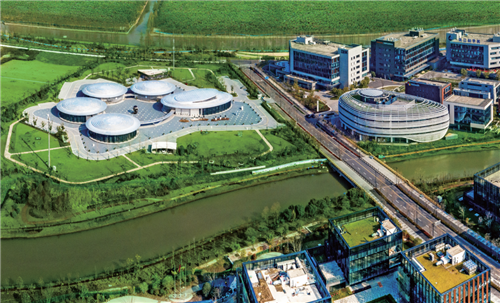Shanghai releases blueprint for Zhangjiang's development in next 10 years

The Zhangjiang zone has made remarkable achievements after 10 years of development. [Photo/china-shftz.gov.cn]
The Zhangjiang National Innovation Demonstration Zone in Pudong New Area, Shanghai will facilitate scientific and technological innovation, make breakthroughs in core technologies in key areas, and lead the high-quality development of the country in the next 10 years, according to a news conference held in Shanghai on March 31.
Since it was approved by the State Council in 2011, the Zhangjiang zone has made remarkable achievements in various areas including institutional innovation, innovation capacity, and cultivating industries.
Zhangjiang has become the frontline of innovation in Shanghai. There are 330 national research and development (R&D) institutions in the zone, such as the Tsung-Dao Lee Institute and the National Center for Protein Science (Shanghai).
The zone currently houses 14 mega science projects that are either in operation or under construction, such as the Shanghai Synchrotron Radiation Facility (SSRF), the largest scientific device and public experimental platform in China. A number of landmark achievements have been made by the zone in basic research and research on core technologies such as the Micius satellite and the black hole image.
The zone is currently a hub for innovative enterprises. There are about 100,000 sci-tech enterprises and more than 9,000 national high-tech enterprises in the zone.
Over the past 10 years, a complete and advanced integrated circuit industrial chain has taken shape in the zone, and the annual output of IC companies exceeded 180 billion yuan ($27 billion) in 2020, taking up 20 percent of China's total.
The zone led the country in the R&D and innovation of biomedicine. According to official data, China's central regulator has approved 99 innovative pieces of medical equipment since 2014, of which 18 came from Zhangjiang. Among the eight antibody drugs approved and available in the market last year, five were developed by companies based in Zhangjiang.
Additionally, the zone has sped up the development of artificial intelligence (AI) over the years, and is now home to more than 2,400 AI companies, accounting for 70 percent of Shanghai's total.
In spite of the COVID-19 pandemic last year, the total revenue of industrial enterprises above designated size in Zhangjiang exceeded 6.2 trillion yuan, growing by 10.8 percent year-on-year, and helped stabilize Shanghai's economic growth.
Government services have been simplified to make the zone attractive for top talent. It is now home to a working population of 2.38 million people, more than 80 percent of whom are young talent. More than 1,000 of these people are national-level or overseas high-end talent and Shanghai Leading Talent.
Additionally, Zhangjiang zone has created a more favorable ecosystem for innovation, with 820 service platforms for innovation and entrepreneurship set up in the zone, including 42 national-level incubators. These platforms have offered a complete service system for the zone's high-growth sci-tech enterprises.
Government officials said that efforts will be made to turn the Zhangjiang zone into the country's frontier for scientific and technological innovation, a hub for breakthroughs in key technologies, and the main driving force for Shanghai's high-quality growth in the coming 10 years.

 Print
Print Mail
Mail




